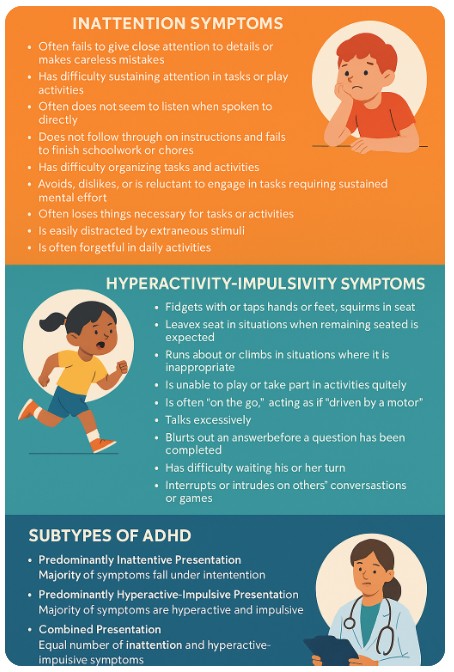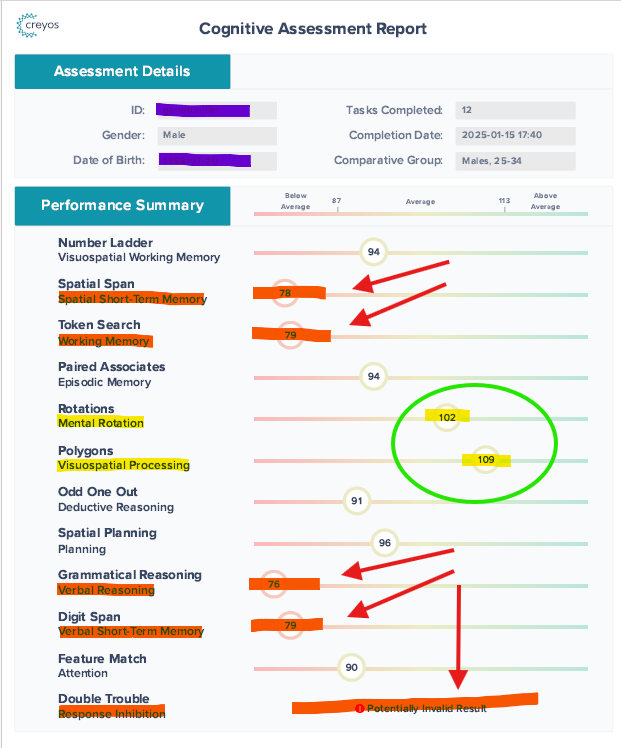Understanding ADHD Symptoms in Children and Teenagers: A Comprehensive Guide
Introduction
Attention-Deficit/Hyperactivity Disorder (ADHD) is a neurodevelopmental disorder characterized by patterns of inattention, hyperactivity, and impulsivity that interfere with functioning or development. It affects approximately 11.4% of U.S. children aged 3–17, highlighting its significance as a public health concern.
DSM-5 Diagnostic Criteria
The Diagnostic and Statistical Manual of Mental Disorders, Fifth Edition (DSM-5), outlines specific criteria for diagnosing ADHD. For children under 17, six or more symptoms of inattention and/or hyperactivity-impulsivity must be present for at least six months in multiple settings.
Inattention Symptoms
- Often fails to give close attention to details or makes careless mistakes.
- Difficulty sustaining attention in tasks or play activities.
- Does not seem to listen when spoken to directly.
- Does not follow through on instructions and fails to finish schoolwork or chores.
- Difficulty organizing tasks and activities.
- Avoids or dislikes tasks requiring sustained mental effort.
- Loses things necessary for tasks or activities.
- Easily distracted by extraneous stimuli.
- Forgetful in daily activities.
Hyperactivity-Impulsivity Symptoms
- Fidgets with or taps hands or feet; squirms in seat.
- Leaves seat in situations when remaining seated is expected.
- Runs about or climbs in inappropriate situations.
- Unable to play or engage in leisure activities quietly.
- Often “on the go” or acts as if “driven by a motor.”
- Talks excessively.
- Blurts out answers before questions have been completed.
- Difficulty waiting for their turn.
- Interrupts or intrudes on others.
Subtypes of ADHD
- Predominantly Inattentive Presentation: Majority of symptoms fall under inattention.
- Predominantly Hyperactive-Impulsive Presentation: Majority of symptoms are hyperactive and impulsive.
- Combined Presentation: Equal number of inattention and hyperactive-impulsive symptoms. (Your child’s risk of ADHD or autism diagnosis depends on their age compared to classmates, scientists say)
Assessment and Diagnostic Tools
Traditional Assessment Methods
- Behavioral Rating Scales: Tools like the Vanderbilt ADHD Diagnostic Rating Scale (VADRS) and the Conners’ Rating Scales are commonly used to assess symptom severity and frequency.
- Clinical Interviews: Structured interviews with parents, teachers, and the child to gather comprehensive behavioral information.
Modern Assessment Tools
- Creyos ADHD Assessment: An innovative tool that combines cognitive tasks to objectively measure brain functions related to attention and executive function. It evaluates 14 specific markers within five cognitive tasks, providing a comprehensive profile of the individual’s cognitive abilities.
- Test of Variables of Attention (TOVA): A computerized continuous performance test that measures attention and inhibitory control. TOVA provides objective data that can aid in the diagnosis of ADHD. (Attention deficit hyperactivity disorder)
Recent Research and Developments
Rising Diagnosis Rates
A study published in 2024 indicates a significant increase in ADHD diagnoses among U.S. children, with approximately one million more children diagnosed in 2022 compared to 2016.
Prenatal Factors
Recent research has linked maternal health conditions, such as diabetes during pregnancy, to a higher risk of neurodevelopmental disorders like ADHD in offspring. (Why do more teens have IBS, eczema and ADHD?)
Advancements in Diagnostic Technology
The integration of EEG and deep learning techniques has shown promise in improving the accuracy of ADHD diagnoses, offering potential for earlier and more precise identification. (An ADHD Diagnostic Interface Based on EEG Spectrograms and Deep Learning Techniques)

Comorbid Conditions and Differential Diagnosis
- Common Comorbidities:
- Learning Disabilities.
- Oppositional Defiant Disorder (ODD).
- Anxiety and Depression.
- Differential Diagnosis:
- It’s crucial to differentiate ADHD from other conditions with overlapping symptoms, such as anxiety disorders, mood disorders, and autism spectrum disorders.
Treatment and Management Strategies
- Behavioral Interventions:
- Parent training in behavior management.
- Behavior therapy with children.
- Educational Interventions:
- Classroom accommodations and individualized education programs (IEPs).
- Medication:
- Stimulant medications (e.g., methylphenidate).
- Non-stimulant medications (e.g., atomoxetine).
- Alternative Therapies:
- Cognitive training programs.
- Dietary modifications and supplementation.
- Neurofeedback training (various formats)
- Direct Neurofeedback
- Traditional Neurofeedback
- Mendi blood flow neurofeedback
- CES CalmBox system
- Lifewave Photo Therapy Patches
Resources and Support
- Organizations:
- Children and Adults with Attention-Deficit/Hyperactivity Disorder (CHADD): https://chadd.org
- Centers for Disease Control and Prevention (CDC) ADHD Information: https://www.cdc.gov/adhd
- Assessment Tools:
- Creyos ADHD Assessment: https://creyos.com
- TOVA Test or other CPT test for ADHD

